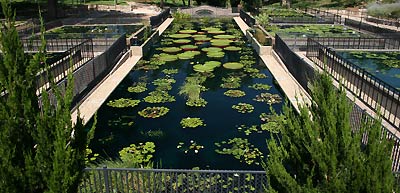
A Place to Fuel the Imagination.
Tropical Night Bloomers
| IWC Home |
| About Us |
| Latest News |
| The Plants |
| The Collection |
| Water Gardening Info & Tips |
| Resources |
| Site Map |

"Clarification Genus Nymphaea Subgenera |
It has been brought to our attention that vague, erroneous and even false literature is being disseminated on the internet etc. regarding several botanical Nymphaea taxons listed on the IWPR* inventory list on the IWGS website. Some of the most recent false information regards three members of the genus Nymphaea of the Lotos subgenus. The false information noted implies that N. lotus (Linnaeus) Willdenow, N. pubescens Willdenow and N. rubra Roxburgh are synonymous. Also it is being reported that N. rubra exist as a mere color form of N. pubescens and that N. lotus is synonymous with N. pubescens. Research has previously and recently revealed that original publications founding these taxons as independent and separate species to be correct. The African N. lotus is distinctly different from the Indian N. pubescens, as type descriptions indicate. These two true independent species produce their own independent progeny (seed) identical to the parent when selfed, without variations regarding plant morphology, including variable floral color. Likewise, the genuine species N. rubra (India), when selfed, produces progeny (seed) only identical to the parent without any color variations with regard to flowers and overall plant morphology excepting nutrition variables. The three species, unfortunately, have been so intermingled in present society that actual genuine species material is becoming rare and endangered. In the wild, and certainly regarding commercial aspects, the intermingled specimens are often confused with the genuine species. Research at the IWPR research center etc. has definitely proven that progeny (seed) of the hybrid forms (F1 etc.) between N. lotus, N. pubescens, and N. rubra can be and are often variable regarding floral color and minimal plant morphology. Recent research suggests that some of the isolated, associated, formed hybrids are capable of producing progeny identical to their hybrid parent, giving rise to a so called species of its own. This member is often referred to as N. spontanea. This predominant fertile, and vigorous Nymphaea of the Lotos subgenus is now generally indigenous throughout many portions of the world in the wild and is concentrated in Thailand, Sri Lanka, etc. N. spontanea and associated hybrids are especially popular raised and sold as aquarium submerged sword plants sometimes referred to and sold as insta-bulbs. The genuine species N. lotus, N. pubescens and N. rubra are inventoried as with most species of the genus Nymphaea at the * International Waterlily Preservation Repository. San Angelo, Texas, United States of America.
![]()
![]()
|
|